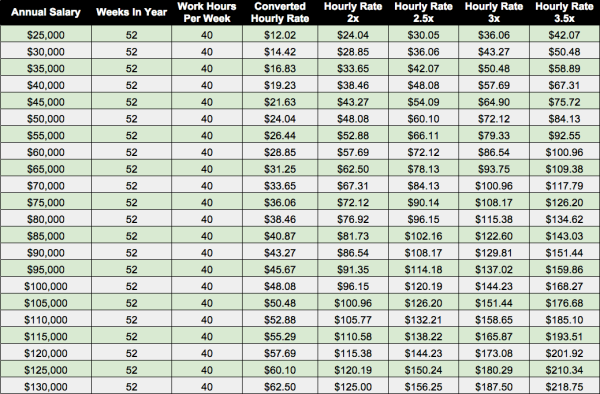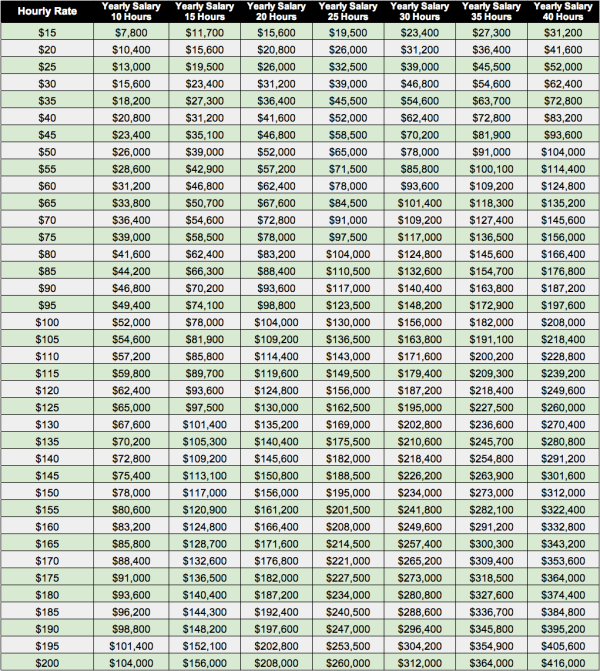At QuoteRobot we often hear both new and established freelancers asking the critical question - "What hourly rate should I charge?". There are definitely a lot of factors involved, but we're just going to cover some basic principles within this post.
Some of the largest factors include experience, location, costs in your area, time of year, and volume. If there's a shortage of work, this can cause a bidding war for freelancers that may cause hourly rates to dip. If there's a shortage of quality freelancers and an influx of jobs, the higher demand may cause higher project costs and hourly rates. By the end of this post you should have a better idea of how to set your Hourly Billable Rate. Let's go!
###STEP 1 - Find Out Your FTE Salary
To determine FTE (Full-Time Equivalent), you should determine the average salary a company would pay for Full-Time Employment. For example, if you rock out awesome design work, you need to determine the annual salary companies pay for Web Designers. Here are some websites to view salaries by profession and company:
Please keep geography/location in mind when referencing salaries, and if you can't find your position, simply search Google for "annual ______ salary" to determine some benchmarks. Take the results with a grain of salt, and determine a reasonable average. Once you have a salary you are comfortable with, divide the salary by 52 (for the number of weeks in a year), and by 40 (number of hours in a week).
Yearly Salary / 52 weeks / 40 hours = hourly rate
Let's take that equation and use 45K as an average annual salary.
45K (annual salary) / 52 (weeks) / 40 (hours) = $21.63 per hour
That's a bit complicated, so we built an excel template to quickly determine your FTE hourly salary - http://bit.ly/QR-Hourly-Excel. Here's a screenshot of hourly rates with 5K increments:
The "Converted Hourly Rate" is your Full Time Equivalent (FTE) hourly rate. If jobs include bonuses, include that within the total salary.
###Step 2: Define Work Hours and Billable Hours
How many hours do you want to work per week? One of the many great joys of freelancing is deciding how many, or little, hours of work you're available to work each week. It's important to identify the difference between Work Hours and Billable Hours. Running your freelance business does not correlate to Billable Hours. You can't charge clients for sending quotes, accounting, invoicing, networking, and walking the pooch. Most freelancers carve out 2-8 hours per week for managing clients and their freelance business. How many hours do you want to work per week? It's a tough question, but if you stay organized you can minimize the number of Non-Billable Time.
###Step 3: Multiply Billable Hourly Rate
The cost of running a freelance business is expensive. You must cover all of the accounting, taxes, legal, hardware, software, telecommunication fees involved with running your own business, not to mention the downtime. Unfortunately, there will be times when your project-pipeline dries up so we recommend a simple equation of 2x, 2.5, or 3x (for experienced or in-high-demand freelancers) as your FTE hourly rate.
For example, if you've determined you'd make 45K annually working full-time then your FTE hourly rate would be $21.63 (from step 1). Take this FTE rate, multiply it by 3x and this will give you your freelance hourly contract rate - $64.89.
###Step 4: Round Up Or Down
Keep clients focused on the project versus your hourly rate calculation process ("Jim, why did you choose $21.69 as a billable rate?"). Always round up or down to the nearest dollar. We also recommend sticking with $5 increments (example $45, $50, $55, $60, $65, etc). Using the 45K example (from step 3), we would round $64.89 to an even $65.
###Step 5: Get Your Math On
Now that you have your FTE hourly rate, your weekly goal for billable hours, and the multiplier set, let's review your yearly projections for annual revenue. This might sound a bit daunting, but we've created a cheat sheet to compare hourly rates sorted by number of hours worked per week (For excel and google drive lovers, we've created a spreadsheet for you to play with on your own - http://bit.ly/QR-Hourly-Excel)
From the 45K example, the FTE is $65 (3x hourly), with a goal of billing 30 hours per week. This works out to $101,400 annually (including taxes), before expenses.
You can use the excel doc or images above/below to quickly review hourly rates, billable times, and revenue goals with billable hours per week. Here are some images for quick reference:
Total Revenue listed by Hourly Rate and Billable Hours:
Revenue Targets By Billable Hours Per Week and Hourly Rate:
###Step 6: Get Your Sleep On
You need to consider other factors when selecting your hourly rate. The location of your client(s) and how competitors' bids will impact your hourly rate. If you bid too low, you will undercut yourself and the market you serve. If you list your price too high, you'll have problems finding work. More importantly, we'd recommend sleeping on it. Take an extra day to think about your hourly rate. Does it make sense? Are you being reasonable? Are you happy with your yearly salary? Is it realistic to fulfill those Billable Goals per week?
Once you have an hourly rate set, it's up to you to continue to monitor trends and average salaries within your space. An easy way to know going rates, is to simply ask other freelancers. In fact, we would recommend every freelancer interact with other freelancers in their industry regularly for knowledge transfer, latest trends, share stories (nightmares and amazing clients), and hourly rates.
Happy Freelancing. If you have any tips or links to add, please let us know!
###Bonus Tip: Pricing is too high, or too low?
Send some quotes! Watch how clients respond. If they drastically increase/reallocate the number of hours for the project, there might be something wrong with your price (it's far too low, or high). If you consistently fail to hear back from clients, your price might be too high.




